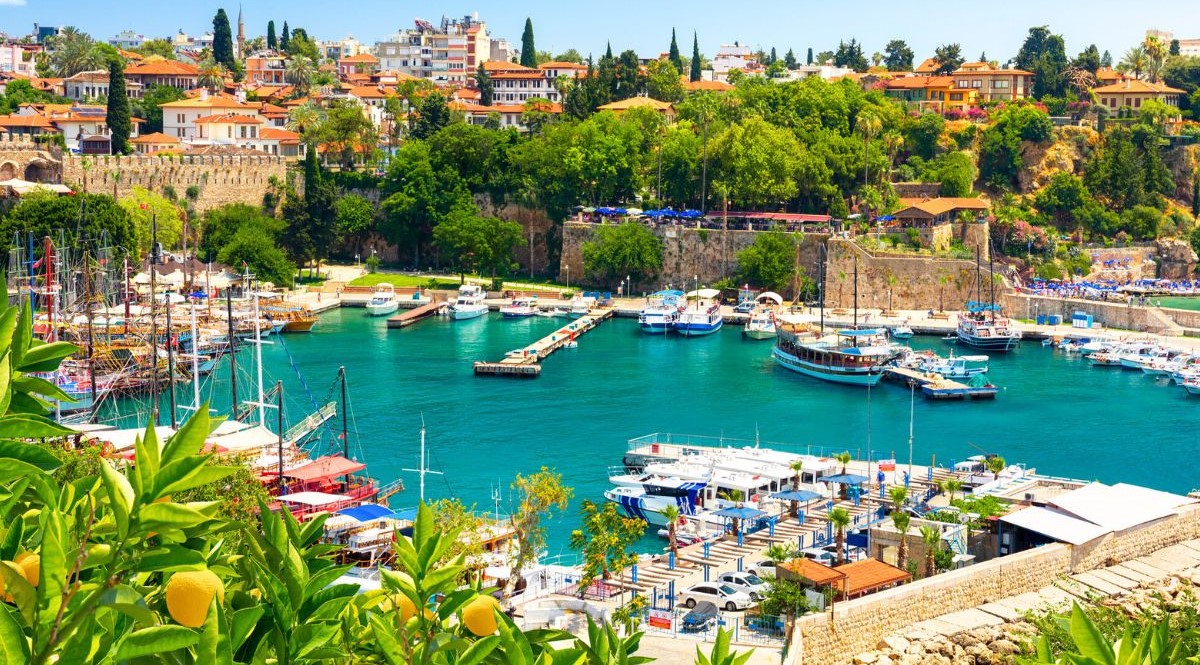Antalya Travel Guide: Must-Do Activities for Tourists in Turkey's Coastal Gem
Antalya is a picturesque city situated on the southwestern coast of Turkey, bordered by the sparkling waters of the Mediterranean Sea. Known for its breathtaking landscapes, Antalya offers a perfect blend of natural beauty and historical richness. Here are some highlights about the city and its history:
Historical Significance: Antalya has a rich history that dates back thousands of years. The region has been home to various civilizations, including the ancient Greeks, Romans, Byzantines, and Ottomans. This diverse historical background is reflected in the city's architecture, archaeological sites, and cultural heritage.
Old Town (Kaleiçi): The heart of Antalya is its charming Old Town, known as Kaleiçi. Cobblestone streets wind through this historic district, lined with Ottoman-era houses, boutique shops, and traditional Turkish restaurants. The area is enclosed by ancient city walls and boasts landmarks like the Hadrian's Gate, a triumphal arch built in the honor of the Roman emperor Hadrian.
Roman Influence: Antalya was an important city during the Roman period, and evidence of this era can be seen in structures like the Roman Harbor, which served as a major port. The city's ancient amphitheater, Aspendos, is renowned for its well-preserved architecture and is still used for cultural events today.
Natural Wonders: Beyond its historical sites, Antalya is celebrated for its natural beauty. The region is surrounded by stunning landscapes, including the Taurus Mountains, pristine beaches, and the Düden Waterfalls. The combination of historical ruins against the backdrop of the Mediterranean Sea makes Antalya a unique and captivating destination.
Museums and Art: Antalya also offers a glimpse into its cultural heritage through various museums. The Antalya Museum is particularly noteworthy, featuring an extensive collection of artifacts from the region's history, including sculptures, ceramics, and mosaics.
Tourism Hub: In recent decades, Antalya has evolved into a major tourism hub, attracting visitors from around the world. The city's modern amenities, luxury resorts, and vibrant nightlife complement its historical allure, making it a well-rounded destination for all types of travelers.
Best Time to Visit Antalya ?
The best time to visit Antalya as a tourist is during the spring (April to June) and autumn (September to October) months. During these periods, the weather is generally pleasant, and the climate is suitable for a variety of outdoor activities. Here are some considerations for each season:
Spring (April to June):
Temperature: Spring in Antalya brings mild and comfortable temperatures, with daytime highs ranging from 20 to 30 degrees Celsius (68 to 86 degrees Fahrenheit).
Blooming Nature: The landscape is lush and green during spring, and flowers are in bloom, enhancing the overall beauty of the region.
Crowds: While it's a popular time to visit, the crowds are generally smaller compared to the peak summer months.
Autumn (September to October):
Temperature: Autumn is characterized by warm temperatures, with highs ranging from 25 to 35 degrees Celsius (77 to 95 degrees Fahrenheit).
Sunny Days: The weather is still pleasant, and the sea remains warm for swimming. Days are sunny, making it suitable for both outdoor activities and cultural exploration.
Reduced Crowds: As the summer tourist season winds down, the number of visitors decreases, providing a more relaxed experience.
While spring and autumn are considered the best times to visit Antalya, it's worth noting that the summer months (July and August) can be quite hot, with temperatures soaring above 35 degrees Celsius (95 degrees Fahrenheit). If you prefer hotter weather and are interested in beach activities, summer might still be a suitable time for your visit.
On the other hand, winter (November to March) can be cooler, with some rainfall, especially in December and January. While it's a quieter time for tourism, certain attractions and activities may be limited during the winter months.
Ultimately, the best time to visit Antalya depends on your preferences and the type of experience you're seeking, whether it's exploring historical sites, enjoying outdoor activities, or simply relaxing on the beaches.
Touristic Points of Antalya ?
Antalya is a city with a rich historical and cultural heritage, stunning natural landscapes, and a variety of attractions for tourists to explore. Here are some of the top tourist points in Antalya:
Aspendos: Home to one of the best-preserved Roman theaters in the world, Aspendos is a must-visit archaeological site. The theater is still used for cultural events and performances.
Perge: An ancient city dating back to Hellenistic times, Perge features well-preserved ruins, including a stadium, agora, and Roman baths. The city was an important center during the Roman Empire.
Antalya Museum: Located in the Konyaaltı district, the Antalya Museum houses a vast collection of artifacts from the region's history, including sculptures, pottery, and jewelry.
Düden Waterfalls: These picturesque waterfalls are located just outside the city center. The Upper Düden Waterfalls are a natural marvel, and the Lower Düden Waterfalls cascade directly into the Mediterranean Sea.
Karaalioglu Park: A scenic park overlooking the Mediterranean Sea, Karaalioglu Park offers a peaceful escape with walking paths, green spaces, and panoramic views of the coast.
Konyaaltı Beach: One of Antalya's popular beaches, Konyaaltı Beach is known for its clear waters and vibrant atmosphere. It's a great spot for swimming, sunbathing, and enjoying water sports.
Termessos: Located in the Taurus Mountains, Termessos is an ancient city with well-preserved ruins, including a theater, agora, and defensive walls. The site offers stunning views of the surrounding mountains.
Yivli Minare Mosque: Also known as the Fluted Minaret, this iconic mosque dates back to the 13th century and is a symbol of Antalya. The minaret features a unique fluted design.
Hadrian's Gate: A triumphal arch built to honor the Roman Emperor Hadrian, this gate is one of the most well-preserved and significant historical landmarks in Antalya.
Olympos: An ancient Lycian city located near the beach, Olympos features ruins of a theater, necropolis, and Roman baths. The beach at Olympos is also known for its natural flames caused by methane emissions.
Phaselis: This ancient Greek and Roman city is situated on the coast and includes well-preserved ruins such as an aqueduct, a theater, and three harbors.
These are just a few of the many tourist points that Antalya has to offer. The city's combination of history, nature, and modern amenities makes it a versatile and appealing destination for a wide range of travelers.
Best Beaches in Antalya ?
Antalya is renowned for its stunning beaches, where turquoise waters meet picturesque landscapes, creating an inviting environment for visitors. Here are some notable beaches in and around Antalya:
Konyaaltı Beach: Located in the heart of Antalya, Konyaaltı Beach is a popular stretch of pebbly shore along the city's western coast. The beach offers clear waters, breathtaking views of the mountains, and a lively atmosphere. Visitors can engage in various water sports, sunbathe, or take a leisurely stroll along the promenade lined with cafes and restaurants.
Lara Beach: Known for its long and sandy coastline, Lara Beach is one of Antalya's most famous beaches. The area is home to several upscale resorts, and the beach itself is well-equipped with facilities for water activities. Lara Beach is ideal for those seeking a more serene and relaxing seaside experience.
Phaselis Beach: Situated near the ancient city of Phaselis, this beach offers a unique blend of history and natural beauty. Visitors can explore the ancient ruins and then unwind on the pebble beach with crystal-clear waters. The surrounding pine forests add a touch of tranquility to the atmosphere.
Çıralı Beach: Located southwest of Antalya, Çıralı Beach is known for its pristine and unspoiled setting. The beach is flanked by lush greenery and is home to the famous Chimaera flames, natural gas vents that emit eternal flames. Çıralı is perfect for those seeking a quieter and more nature-oriented beach experience.
Adrasan Beach: Nestled within a bay and surrounded by pine-covered hills, Adrasan Beach offers a tranquil escape from the hustle and bustle. The shallow and calm waters make it suitable for families, and the laid-back atmosphere is ideal for relaxation.
Olympos Beach: Adjacent to the ancient city of Olympos, this beach is known for its natural beauty and historic surroundings. Visitors can explore the ruins of Olympos and then enjoy the pebble beach and refreshing sea.
Kaputaş Beach: Although located a bit farther from Antalya in the Kas district, Kaputaş Beach is worth the trip for its stunning setting. The beach is framed by steep cliffs, and the turquoise waters create a captivating contrast with the golden sands.
Cleopatra Beach (Alanya): While technically not in Antalya but nearby in Alanya, Cleopatra Beach is famous for its fine golden sand and clear Mediterranean waters. According to legend, Cleopatra herself once swam here, adding to the beach's allure.
These beaches showcase the diverse coastal beauty that Antalya and its surrounding areas have to offer. Whether you prefer lively city beaches or secluded natural coves, Antalya provides a range of options for beachgoers to enjoy the Mediterranean sun and sea.
What is most safe to reserve your Hotel, Tours and transfers?
The most safe way for visitors to Antalya to book their tour, hotel accommodations, and transfers is useing Tripfloric.com platform.




